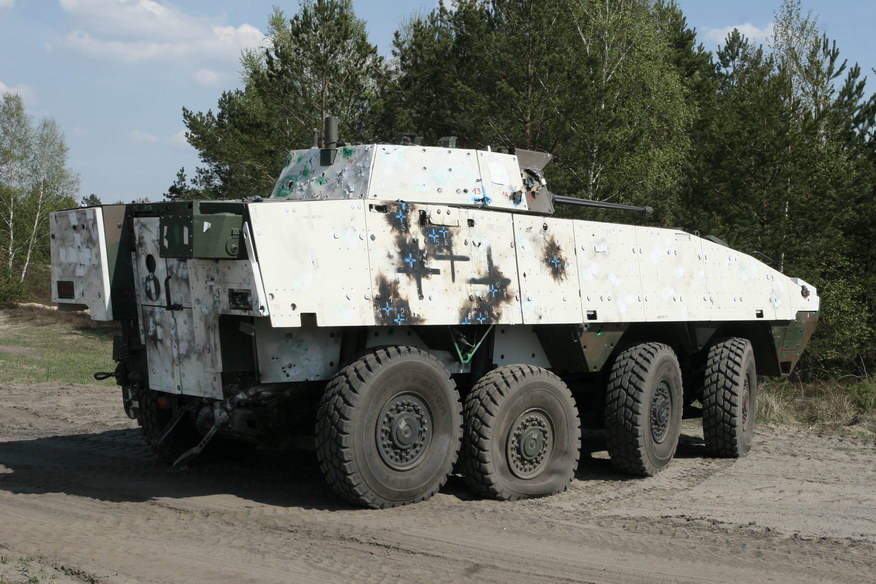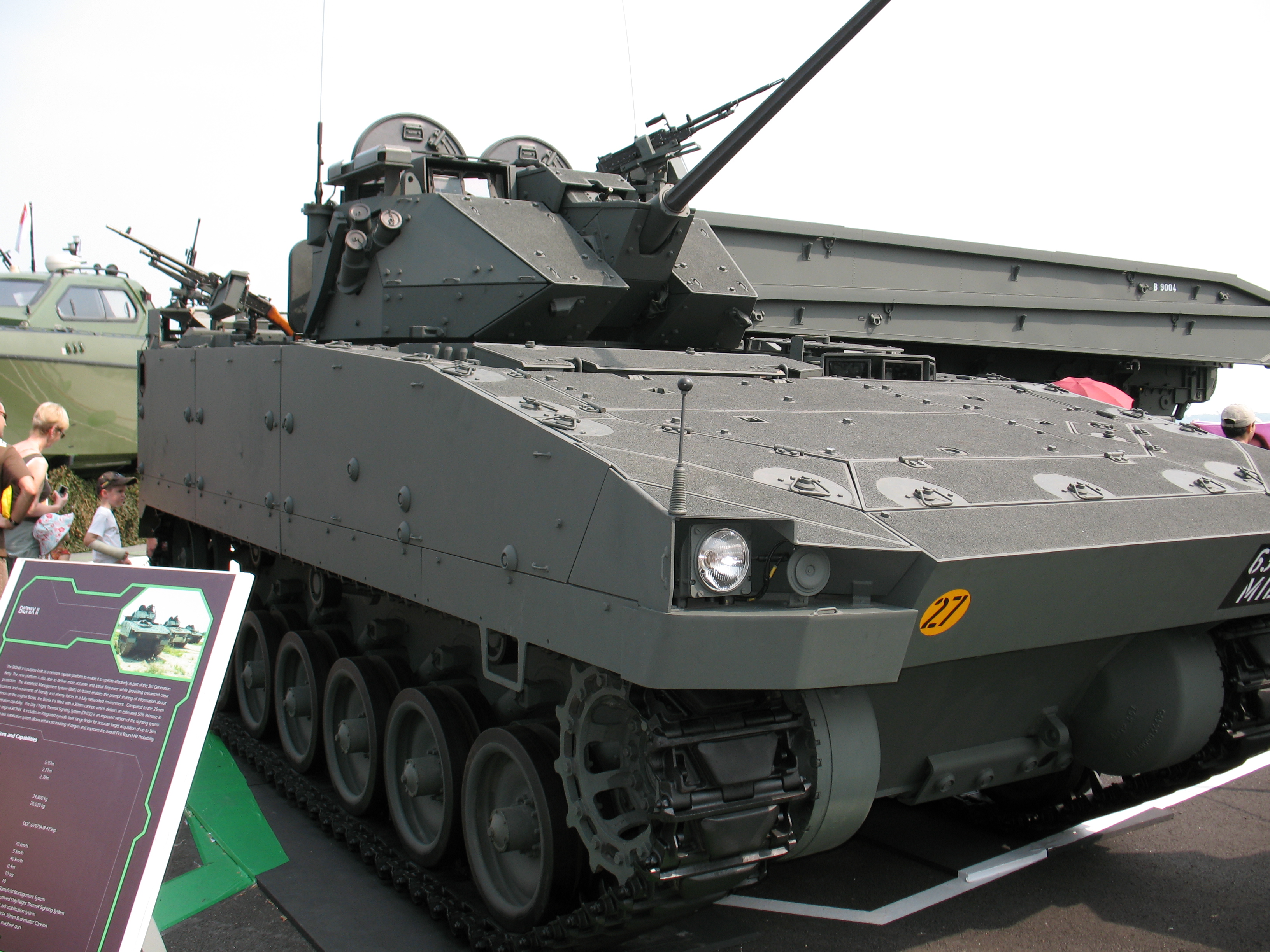|
Tulpar (IFV)
Tulpar is a Turkish heavy infantry fighting vehicle designed by the Sakarya-based automotive manufacturer Otokar. It is named after the Tulpar, a winged horse in Turkic mythology. The vehicle has been designed to augment Turkey's new-generation Altay MBT in operations and to safely transport infantry to the front lines while providing fire support for other armored units. The IFV is also available in variants such as reconnaissance, command-and-control, personnel carrier, mortar, recovery, launch rocket system, air defence, ambulance and anti-tank vehicles. Background Even though the TSK has not formally posted an immediate requirement for a new infantry fighting vehicle, Otokar has started the development of Tulpar along with the Altay. Indeed, Tulpar was designed by the same team that developed Altay. After a 3-year design and development stage, Tulpar was finally unveiled to the public in 2013 at the IDEF international defense fair in Istanbul. Design Tulpar was designed fo ... [...More Info...] [...Related Items...] OR: [Wikipedia] [Google] [Baidu] |
STANAG 4569
NATO AEP-55 STANAG 4569 is a NATO Standardization Agreement covering the standards for the "Protection Levels for Occupants of Logistic and Light Armored Vehicles". The standard covers strikes from kinetic energy, artillery and IED blasts. Level 1 Kinetic Energy 7.62×51mm NATO Ball (Ball M80) at 30 meters with velocity 833 m/s 5.56×45mm NATO Ball (SS109) at 30 meters with a velocity of 900 m/s 5.56×45mm NATO Ball (M193) at 30 meters with a velocity of 937 m/s Protection against all three threats must be provided. Grenade and Mine Blast Hand grenades, unexploded artillery fragmenting submunitions, and other small anti personnel explosive devices detonated under the vehicle. Artillery 20 mm FSP (simulating 155 mm threat) at 520 m/sec from a distance of 100 meters. (Due to very low probability of a large fragment retaining enough velocity at these distances, STANAG 4569 makes this optional.) Angle: azimuth 360°; elevation: 0–18° Level 2 ... [...More Info...] [...Related Items...] OR: [Wikipedia] [Google] [Baidu] |
BMP-3
The BMP-3 is a Soviet and Russian infantry fighting vehicle, successor to the BMP-1 and BMP-2. The abbreviation BMP stands for ''boevaya mashina pehoty'' (, literally "infantry combat vehicle"). Production history The design of the BMP-3 ('' Obyekt'' 688M) can be traced back to the ''Obyekt'' 685 light tank prototype with an 2A48-1 100 mm gun from 1975.Zaloga, Steven J., Hull, Andrew W. and Markov, David R. (1999). ''Soviet/Russian Armor and Artillery Design Practices: 1945 to Present''. Darlington Productions. The prototype did not enter series production, but the chassis, with a new engine, was used for the next-generation infantry combat vehicle ''Obyekt'' 688 from A. Blagonravov's design bureau. The Ob. 688's original weapon configuration consisting of an externally mounted Shipunov 2A42 30 mm autocannon, a 7.62mm PKT machine gun and twin ''9M113 Konkurs'' ATGM launcher was rejected; instead the new 2K23 armament system was selected. The resulting BMP-3 was deve ... [...More Info...] [...Related Items...] OR: [Wikipedia] [Google] [Baidu] |
Bionix AFV
The Bionix (BX) is a family of tracked Singaporean armoured fighting vehicles developed by Singapore Technologies Kinetics (formerly Singapore Technologies Automotive, which is now known as Singapore Technologies Engineering). Intended to augment the Singapore Army's aging M113 armoured personnel carriers, it is the first indigenous armoured vehicle to be developed in Southeast Asia. The Bionix has been operational with the Singapore Armed Forces (SAF) since 1999 in a wide variety of adaptations including the Bionix II, Bionix 25 and Bionix 40/50 variants. Aside from domestic use, ST Kinetics has been marketing the Bionix to countries that wish to retire their old M113s from front-line service. Production History and Development Along with the growth and development of the Singapore Armed Forces (SAF) during the mid 1980s came a need to bolster (and eventually replace) the existing fleet of M113 Armored Personnel Carriers (APCs). This prompted the Ministry of Defence (MINDEF) t ... [...More Info...] [...Related Items...] OR: [Wikipedia] [Google] [Baidu] |
ASCOD
The ASCOD (Austrian Spanish Cooperation Development) armoured fighting vehicle family is the product of a cooperation agreement between Austrian Steyr-Daimler-Puch AG and Spanish General Dynamics Santa Bárbara Sistemas ( both companies are now divisions of a unit of General Dynamics). The ASCOD family includes the LT 105, a light tank equipped with a 105 mm gun, a surface-to-air missile (SAM) launcher, an anti-tank missile launcher, mortar carrier, R&R vehicle, Command & Control vehicle, ambulance, artillery observer, and the AIFV model. In Spanish service, the vehicle is called "Pizarro", while the Austrian version is called "Ulan". History The ASCOD was designed to replace the older light armoured fighting vehicles of the Austrian and Spanish armies, such as the M113 armored personnel carrier and the Saurer APC. The Ulan, the Austrian version of the Pizarro, would provide a flexible complement to their heavy Leopard 2A4. The Ulan would allow the Austrian army to ... [...More Info...] [...Related Items...] OR: [Wikipedia] [Google] [Baidu] |
Anders (tank)
The WPB Anders ( pl, Wielozadaniowa Platforma Bojowa Anders i.e., Anders Multirole Combat Platform) is a family of medium, tracked combat vehicles. The vehicle was designed by OBRUM ( pl, Ośrodek Badawczo-Rozwojowy Urządzeń Mechanicznych – Research and Development Centre for Mechanical Appliances) part of the ''Bumar Group'' (now Polish Armaments Group). It is named after Władysław Anders, a general of the Polish Army during World War II and later a member of the Polish government-in-exile. History The vehicle was designed to replace the Polish Army's remaining inventory of obsolete BWP-1 fighting vehicles family, the first prototype being publicly shown in 2010, at the MSPO Kielce defense industry exhibition. During its first presentation, the vehicle was shown in its fire support configuration ( pl, wóz wsparcia ogniowego), armed with a 120-mm tank gun. The media referred to this vehicle as a "light tank". Later, the same vehicle was shown configured as an infantry fi ... [...More Info...] [...Related Items...] OR: [Wikipedia] [Google] [Baidu] |
Situational Awareness
Situational awareness or situation awareness (SA) is the perception of environmental elements and events with respect to time or space, the comprehension of their meaning, and the projection of their future status. An alternative definition is that situation awareness is adaptive, externally-directed consciousness that has as its products knowledge about a dynamic task environment and directed action within that environment. However, while Endsley's definition is widespread, the theory and measures used to develop it do not attract widespread consensus. SA is a nebulous concept which shares many criticisms with those levelled at the idea of consciousness itself. An early criticism of the definition and model illustrates a reasoning fallacy which has yet to be addressed in the development of SA definition and theory: Situation awareness has been recognized as a critical, yet often elusive, foundation for successful decision-making across a broad range of situations, many of which ... [...More Info...] [...Related Items...] OR: [Wikipedia] [Google] [Baidu] |
Umtas
UMTAS or Mizrak-U ''(Uzun Menzilli Tanksavar Sistemi)'' is a modern long range air-to-surface anti-tank guided missile developed by Turkish armor and missile manufacturer Roketsan. Background The UMTAS program was begun in late 2003 by Turkey's Undersecretariat for Defence Industries (SSM), specifically to provide TAI/AgustaWestland T129 ATAK combat helicopters with an indigenous guided missile. The UMTAS has been designed to engage tanks and heavily armoured vehicles. It can be integrated in various platforms, including helicopters, UAVs, land vehicles, stationary platforms, light assault aircraft, ships. Description The UMTAS missile has ''fire and forget'' and ''fire and update'' infrared guidance with a tandem anti-tank warfare warhead. The laser guided version is marketed as the L-UMTAS. İsmail Demir, the Head of Defence Industry of Turkiye stated that it can engage targets at 16 kilometers. Abilities: * Fire behind mask * Can be used day or night and in adverse weather * ... [...More Info...] [...Related Items...] OR: [Wikipedia] [Google] [Baidu] |
Coaxial
In geometry, coaxial means that several three-dimensional linear or planar forms share a common axis. The two-dimensional analog is ''concentric''. Common examples: A coaxial cable is a three-dimensional linear structure. It has a wire conductor in the centre (D), a circumferential outer conductor (B), and an insulating medium called the dielectric (C) separating these two conductors. The outer conductor is usually sheathed in a protective PVC outer jacket (A). All these have a common axis. The dimension and material of the conductors and insulation determine the cable's characteristic impedance and attenuation at various frequencies. Coaxial rotors are a three-dimensional planar structure: a pair of helicopter rotors (wings) mounted one above the other on concentric shafts, with the same axis of rotation (but turning in opposite directions). In loudspeaker design, coaxial speakers A coaxial loudspeaker is a loudspeaker system in which the individual driver units radiate s ... [...More Info...] [...Related Items...] OR: [Wikipedia] [Google] [Baidu] |
Mızrak-U
UMTAS or Mizrak-U ''(Uzun Menzilli Tanksavar Sistemi)'' is a modern long range air-to-surface anti-tank guided missile developed by Turkish armor and missile manufacturer Roketsan. Background The UMTAS program was begun in late 2003 by Turkey's Undersecretariat for Defence Industries (SSM), specifically to provide TAI/AgustaWestland T129 ATAK combat helicopters with an indigenous guided missile. The UMTAS has been designed to engage tanks and heavily armoured vehicles. It can be integrated in various platforms, including helicopters, UAVs, land vehicles, stationary platforms, light assault aircraft, ships. Description The UMTAS missile has ''fire and forget'' and ''fire and update'' infrared guidance with a tandem anti-tank warfare warhead. The laser guided version is marketed as the L-UMTAS. İsmail Demir, the Head of Defence Industry of Turkiye stated that it can engage targets at 16 kilometers. Abilities: * Fire behind mask * Can be used day or night and in adverse weathe ... [...More Info...] [...Related Items...] OR: [Wikipedia] [Google] [Baidu] |
Automatic Transmission
An automatic transmission (sometimes abbreviated to auto or AT) is a multi-speed transmission used in internal combustion engine-based motor vehicles that does not require any input from the driver to change forward gears under normal driving conditions. It typically includes a transmission, axle, and differential in one integrated assembly, thus technically becoming a transaxle. The most common type of automatic transmission is the hydraulic automatic, which uses a planetary gearset, hydraulic controls, and a torque converter. Other types of automatic transmissions include continuously variable transmissions (CVT), automated manual transmissions (AMT), and dual-clutch transmissions (DCT). An electronic automatic transmission (EAT) may also be called an electronically controlled transmission (ECT), or electronic automatic transaxle (EATX). A hydraulic automatic transmission may also colloquially called a " slushbox" or simply a "torque converter", although the latter term c ... [...More Info...] [...Related Items...] OR: [Wikipedia] [Google] [Baidu] |
Turbo Charge
In an internal combustion engine, a turbocharger (often called a turbo) is a forced induction device that is powered by the flow of exhaust gases. It uses this energy to compress the intake gas, forcing more air into the engine in order to produce more power for a given displacement. The current categorisation is that a turbocharger is powered by the kinetic energy of the exhaust gasses, whereas a supercharger is mechanically powered (usually by a belt from the engine's crankshaft). However, up until the mid-20th century, a turbocharger was called a "turbosupercharger" and was considered a type of supercharger. History Prior to the invention of the turbocharger, |



.jpg)

